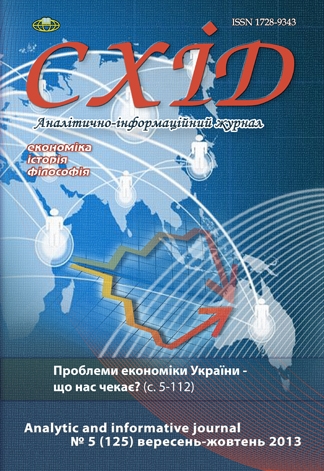Modeling of divergent-convergent processes in the management of the development of the industrial enterprise
DOI:
https://doi.org/10.21847/1728-9343.2013.5(125).114140Keywords:
modeling, management, provision, development, industrial enterprise, divergent-convergent processesAbstract
It is proved in the article that the processes of managing the provision of the development project proceed from the periphery to the functional center, which is reflected in the release of working capital and the reorientation of production capacities.
Based on the use of mathematical analysis tools, an approach to modeling of divergent-convergent processes in the management of the provision of the development of the industrial enterprise, based on the non-typical conditions (crisis in the enterprise, technological breakthrough in the industry), in which the implementation of the selected measures for the development of the enterprise takes place, is substantiated.Downloads
References
Grozny, I.S. (2012), Analysis of approaches to the management of the development of an industrial enterprise, Economy of nature management and environmental protection: The work of the DonNUU. Series «Economics», pp. 51-57 (ukr).
McMillan, S. (2012), The Involvement of State Governments in US Foreign Relations, Palgrave Macmillan, a division of Nature America Inc, p. 269. DOI 10.1057/9781137015402.
Uk Heo (2013), Terence Roehrig South Korea’s Rise: Economic Development, Power, and Foreign Relations, Cambridge University Press. p. 215. https://doi.org/10.1017/CBO9780511998355
Stankovsky, Jan (1990), Economic Policy and Foreign Trade in Austria: Relations with West and East, The Challenge of Simultaneous Economic Relations with East and West, Palgrave MacmillanUK, p. 80-108. DOI 10.1007/978-1-349-11409-2_6
Reeves, J. (2013), Chinese Foreign Relations with Weak Peripheral States: Asymmetrical Economic Power and Insecurity, Routledge,New York. DOI 10.4324/9781315709628
Zhu, Feng (2011), China’s Trouble with the Neighbors, Project Syndicate, October 31, available at: http://www.project-syndicate.org/commentary/china-s-trouble-with-the-neighbors.
United Nations Economic and Social Commission for Asiaand the Pacific (2012). Asia-Pacific Trade and Investment Report, United Nations Economic and Social Commission for Asia and the Pacific,Bangkok, 40 p.
Khrawish, Husni Ali (2013), The Effect of Economic and Financial Risks on Foreign Direct Investment in Jordan: Multivariate Analysis. International Business Research, Vol. 7, No 5, pp. 124-136. DOI: http://dx.doi.org/10.5539/ibr.v7n5p124
Feiqiong, Chena & Fangfang, Zhongb & Yao, Chenc (2012), Outward foreign direct investment and sovereign risks in developing host country. Economic Modelling Vol. 41, pp. 166-172. http://doi.org/10.1016/j.econmod.2014.05.011
Pace, D. K. (2012), Comprehensive consideration of uncertainty in simulation use. The Journal of Defense Modeling and Simulation: Applications, Methodology, Technology, Vol 10, Issue 4, pp. 367-380. https://doi.org/10.1177/154851291245547
Roza, Z.C. (2004), Simulation fidelity: theory and practice (a unified approach to defining, specifying and measuring the realism of simulations). Delft University Press, Deft, The Netherlands.
Downloads
Published
How to Cite
Issue
Section
License
Copyright (c) 2017 Olga Rusinova

This work is licensed under a Creative Commons Attribution-NonCommercial-NoDerivatives 4.0 International License.
1. Authors bear responsibility for the accuracy of facts, quotations, numbers and names used.
2. Manuscripts are not sent back.
3. The publisher does not always agree with the authors' opinion.
4. The authors reserve the right to authorship of the work and pass the first publication right of this work to the journal under the terms of a Creative Commons Attribution-NonCommercial-NoDerivatives 4.0 International License. This license allows others to distribute (copy) the published work for non-commercial purposes, provided there is mandatory attribution to its authors and a link to the first publication in our journal.
5. The authors have the right to conclude separate supplement agreements that relate to non-exclusive work distribution in the form in which it has been published by the journal (for example, to upload the work to the online storage of the journal or publish it as part of a monograph), provided that the reference to the first publication of the work in this journal is included.

